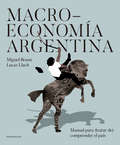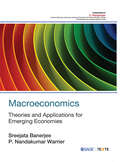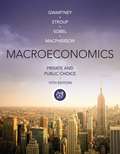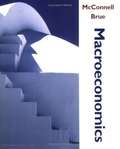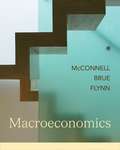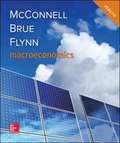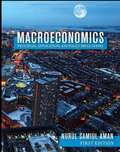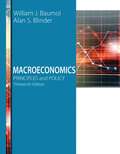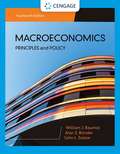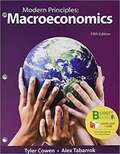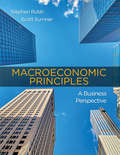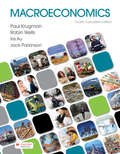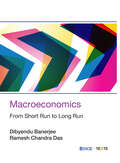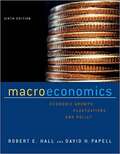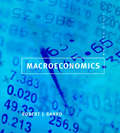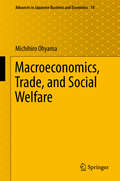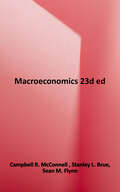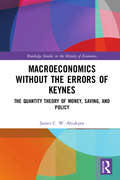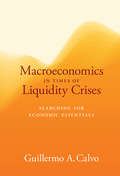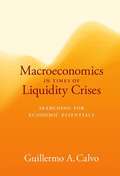- Table View
- List View
Macroeconomía argentina: Manual para (tratar de) comprender el país
by Lucas Llach Miguel BraunBraun y Llach presentan de modo simple, consistente y realista las nociones básicas de la macroeconomía y las aplican de manera aguda y original a las peculiaridades del caso argentino. Pensado y escrito desde la perspectiva de nuestra economía, este libro es no sólo un manual completo sobre los conceptos fundamentales de la macroeconomía, sino también una caja de herramientas accesible y eficaz para entender los debates actuales sobre la realidad argentina. ¿Por qué algunos países son ricos y otros pobres? ¿Qué factores determinan el crecimiento económico? ¿Cómo inciden las políticas públicas en los niveles de producción, empleo y precios? ¿Cuáles son las causas de la inestabilidad argentina? ¿Qué papel juega la globalización en una economía como la nuestra? ¿De qué dependen los movimientos de los precios o del tipo de cambio? ¿De qué hablamos cuando hablamos de inflación o déficit fiscal?
Macroeconomics: Theory Through Applications
by Russell Cooper A. Andrew JohnThis textbook, Macroeconomics: Theory Through Applications, centers around student needs and expectations through two premises: ... Students are motivated to study economics if they see that it relates to their own lives. ... Students learn best from an inductive approach, in which they are first confronted with a problem, and then led through the process of solving that problem. Many books claim to present economics in a way that is digestible for students; Russell and Andrew have truly created one from scratch. This textbook will assist you in increasing students' economic literacy both by developing their aptitude for economic thinking and by presenting key insights about economics that every educated individual should know.
Macroeconomics: Theories and Applications for Emerging Economies
by Sreejata Banerjee P. Nandakumar WarrierA comprehensive text on macroeconomic theories with reference to developing economies. This new textbook presents macroeconomic theory and its implications in policy formulation in a unique manner, continuously weaving in scenarios from India and other emerging economies. While the book meticulously guides the reader through the workings of key macroeconomic models, it also discusses at length the assumptions that make the models applicable to developing market nations. It offers interesting insights into the Simple Keynesian Cross Model, international capital movement and different schools of macroeconomic thought, and compares macroeconomic models of developed and developing economies. Key Features: Boxed text highlighting experiences of emerging market economies and demonstrating the role of macroeconomic theory in policy implications Use of charts and tables with current data for better comprehension and illustration of the theories and inter-linkages of macroeconomic forces Theoretical content of each chapter is illustrated and supplemented by relatable examples and case studies based on policies undertaken by the Indian economy A must-have companion for students of economics, policy studies, management, administrative services, commerce and others
Macroeconomics: Private and Public Choice (15th Edition)
by James D. Gwartney David A. Macpherson Russell S. Sobel Richard L. StroupMACROECONOMICS: PRIVATE AND PUBLIC CHOICE, Fifteenth Edition, reflects current economic conditions, enabling students to apply economic concepts to the world around them, and includes a robust set of online multimedia learning tools.
Macroeconomics: Principles, Problems, and Policies (Sixteenth Edition)
by Stanley L. Brue Campbell McconnellRevisions of previous books by the authors on macroeconomics and microeconomics. They have been updated to reflect the latest developments in economics. They feature a fully integrated global perspective and a new design and art programme.
Macroeconomics: Principles, Problems, and Policies (18th Edition)
by Campbell R. Mcconnell Stanley L. Brue Sean M. FlynnThis book elaborates on the principles essential for understanding the economizing problem, specific economic issues, and the policy alternatives and helps to apply the economic perspective.
Macroeconomics: Principles, Problems, and Policies
by Stanley L. Brue Sean M. Flynn Campbell R. McConnellMcConnell/Brue/Flynn has long set the standard for providing high-quality content to instructors and students alike. Known for versatility, comprehensiveness, and persistent innovation, it has remained one of the most trusted and reliable choices for principles of economics courses. The 21st edition continues to benefit from author Sean Flynn's influence with new discussion on strategic behavior, game theory, unconventional monetary policy and interest rate normalization. A robust set of content designed to facilitate classroom engagement through peer instruction has been developed to align with the learning objectives in the text. New innovations like interactive graphs and videos combine with Smartbook's adaptive reading experience and even more algorithmic and graphing assessment content in Connect to help students success in the course. McConnell/Brue/Flynn is expertly tailored to support a variety of course formats, institutions, and students. Its depth of content and breath of resources continue to be unparalleled in the introductory market.
Macroeconomics: Principles, Applications, and Policy Implications
by Nurul Samiul AmanMacroeconomics Principles, Applications and Policy Implications introduces students to foundational principles of modern economics with real-world applications. The text draws connections between key concepts and sports, music, entertainment, the housing market, the bond market, the stock market, the loanable funds market, and other related financial markets. <p><p> The book begins by addressing the scarcity of economic resources and the rationale for studying economics in order to maximize the economic and social impact of limited resources. Later chapters introduce supply and demand models, criteria for determining market efficiency, key macroeconomic variables, Keynesian macroeconomics, and fiscal and monetary policy. Students learn about the policy implications for business cycle fluctuations, basic theories of monetary economics, and the current state of the budget deficit and public debt for the U.S. economy. The text addresses the causes and consequences of inflation and unemployment, including the theory of inflation and unemployment tradeoffs resulting in stagflation. Closing chapters discuss the open economy macro model, as well as the foreign exchange market and its role in the global economy. <p><p> Macroeconomics Principles, Applications and Policy Implications is an ideal resource for foundational courses in economics.
Macroeconomics: Principles for a Changing World (Fourth Edition)
by Eric ChiangWith this edition, Eric Chiang begins a new era for his acclaimed principles of economics textbook. Formerly CoreEconomics and now titled Economics: Principles for a Changing World, the new edition is thoroughly contemporary, fully integrated print/technology resource that adapts to the way you want to teach. As always, this concise book focuses on the topics most often covered in the principles course, but with this edition, it offers a stronger emphasis than ever on helping students apply an economic way of thinking to the overwhelming flow of data we face every day. Economics: Principles for a Changing World is fully informed by Eric Chiang's experiences teaching thousands of students worldwide, both in person and online. Developing the text, art, media, homework, and ancillaries simultaneously, Chiang translates those experiences into a cohesive approach that embodies the book's founding principles:To use technology as a tool for learning--before lectures, during class, when doing homework, and at exam timeTo help students harness the data literacy they'll need as consumers of economic informationTo provide a truly global perspective, showing the different ways people around the world confront economic problems
Macroeconomics: Principles and Applications (6th Edition)
by Robert E. Hall Marc LiebermanDiscover how today's macroeconomic policy issues, decisions, and applications impact you every day with the practical, accessible presentation in MACROECONOMICS. Written by acclaimed economists Hall and Lieberman, this straightforward contemporary text offers a presentation as current as the latest headlines. Fresh new cutting-edge examples throughout this edition as well as updated mini-cases clearly illustrate core macroeconomic principles and applications in action. This edition's streamlined chapters focus on today's most important macroeconomic theories and events. The latest thinking from leading economists helps equip readers with a solid foundation in macroeconomics necessary for success, no matter what the career.
Macroeconomics: Principles And Policy
by Alan Blinder William BaumolTake a policy-based approach to teaching introductory economics with Baumol/Blinder's MACROECONOMICS: PRINCIPLES AND POLICY, 13E. <P><P>Written by two of the most respected economists in the world, this edition is one of the most current economics texts on the market with data into 2014. <P>Significant updates reflect the most recent economic events and policy developments, which the authors skillfully relate to the book's concepts and principles using the right level of rigor and detail. <P>Guide readers in mastering the basic principles of economics with the strong policy-based approach and vivid, current examples found only in MACROECONOMICS: PRINCIPLES AND POLICY.
Macroeconomics: Principles And Policy
by William J. Baumol Alan S. Blinder John L. SolowMaster today's principles of macroeconomics and gain an understanding of current economic issues and their importance as Baumol/Blinder/Solow's MACROECONOMICS: PRINCIPLES AND POLICY, 14E provides a solid introduction to macroeconomics using policy-based examples and applications. Written by several of today's most respected economists, this book is one of the most up-to-date macroeconomics choices on the market -- incorporating data and issues as recent as 2018. The authors combine the right level of rigor and detail to clarify even the most complicated macroeconomics concepts. An entirely new chapter closes the book by delving into some of the most important issues confronting the U.S. economy today. Throughout this edition, well-developed examples, intriguing puzzles and meaningful macroeconomics issues provide an excellent balance of theory to application while keeping you engaged and intrigued.
Macroeconomics: Modern Principles
by Tyler Cowen Alex TabarrokAvailable for the first time with Macmillan's new online learning platform, Achieve, Modern Principles is a tour-de-force with a unique combination of vivid writing, up-to-date relevant examples, and online resources unlike any other textbook for this market. <p><p> Tyler Cowen and Alex Tabarrok have long demonstrated their mastery at communicating economic principles in a clear, captivating way through their blog, The Marginal Revolution. And they are pioneers in online education. Their fully updated new edition has more high-quality material designed for online teaching than any other principles of economics textbook. Videos from Marginal Revolution University (MRU), Discovering Data questions, live links to FRED data, an e-book, and assessment all live under Macmillan's new learning platform, Achieve and combine to provide an online learning product for all types of learners whether in face to face, hybrid or pure online classes.
Macroeconomics: Macroeconomics And Social Policy In Memory Of William S. Vickrey
by Rubb SumnerCreated specifically for the economics course as taught in business schools, Economic Principles: A Business Perspective covers the fundamentals of economics in the context of today's globalized business world, with strong examples, integrated technology, and practical pedagogy. <P><P>Integrated business and policy briefs, in-depth case studies, chapter-ending business applications, thoroughly explained graphs and a battery of simple but useful learning tools support the intersection of theory and practice. <P><P>It's accompanied by a robust media component, SaplingPlus, which combines Sapling's acclaimed online homework with a complete e-book and all interactive features for the text.
Macroeconomics: Instructor's Manual (Nber Macroeconomics Annual Ser.)
by Paul Krugman Robin Wells Iris Au Jack ParkinsonWhen it comes to explaining fundamental economic principles by drawing on current economic issues and events, there is no one more effective than Nobel laureate and New York Times columnist Paul Krugman and co-authors, Robin Wells, Iris Au, and Jack Parkinson. In this best-selling introductory textbook, the authors’ signature storytelling style and uncanny eye for revealing examples help readers understand how economic concepts play out in our world. Canadian co-authors Jack Parkinson and Iris Au have enhanced the text with current Canadian examples.
Macroeconomics: From Short Run to Long Run
by Ramesh Chandra Das Dibyendu BanerjeeThis comprehensive textbook deals with multidimensional aspects of macroeconomics through lucid presentation of concepts and critical comparison of different schools of thoughts. Macroeconomics: From Short Run to Long Run presents a clear explanation of how the incomes of a country, prices of goods and services, level of employment, interest rates and so on are determined and how an economy progresses. The book attempts to re-establish the existing theories behind the determination of macro variables and the growth process of an economy. In the process, it captures the significance of the debate between the classical orthodox theories and Keynesian modernism and its implications. Besides adhering to traditional aspects, the book also focuses on recent developments such as green macroeconomics. Undergraduate and postgraduate students of economics and business economics will find this book immensely helpful. Key Features: • Provides empirical verification of theories where necessary. • Offers insightful content and critical analysis of environmental factors in the study of macroeconomics. • Chapters aided by mathematical explanations, quantitative problems and their solutions, and a plethora of objective review questions.
Macroeconomics: Economic Growth, Fluctuations, And Policy
by Robert E. Hall David H. PapellOver five editions, Macroeconomics has remained among the most popular intermediate texts in the field. The Sixth Edition incorporates the most current data and theory into the text’s signature single-model approach, clearly demonstrating the real-world applications of macroeconomic theory. Additionally, the Sixth Edition has been revised to include updated and expanded coverage of long-run economic growth, the Taylor Rule, and international economics. A revised study guide and a new online edition of Macrosolve, the innovative multimedia learning resource, are fully integrated with the text.
Macroeconomics, fifth edition (The\mit Press Ser.)
by Robert J. BarroRobert Barro's Macroeconomics has become the classic textbook presentation of the equilibrium approach to macroeconomics. In its first four editions, this book has shown undergraduates how market-clearing models with strong microeconomic foundations can be used to understand real-world phenomena and to evaluate alternative macroeconomic policies. Moreover, a single, unified framework works as well for short-term business fluctuation as for long-term economic growth. This latest edition includes the most recent theoretical and empirical developments in economic growth, recent evidence on the macroeconomics of labor markets and public finance, and up-to-date results on the interplay between nominal and real variables.
Macroeconomics, Trade, and Social Welfare
by Michihiro OhyamaThis book develops new, original methods of welfare comparison and comparative dynamics between distinct and discretely positioned (rather than continuously related) socioeconomic situations. These methods are not only realistic but also extremely relevant to serious economic problems. Using them, the book sheds illuminating new light on the theoretical analysis of Keynesian economics and other important issues of political economy. For instance, it shows that the principle of effective demand applies exactly as Keynes put it to the unemployment equilibrium in the short run. It also shows that the equilibrium may change along the expansion path as the government chooses to vary its expenditure to maximize national welfare. The same methods are effectively employed theoretically to investigate modern trade policy issues such as gains from trade, the theory of tariffs, free trade agreements, and the role of the WTO. Those methods are also used to study the welfare and efficiency of various socioeconomic situations.
Macroeconomics, 6th Custom Edition for Temple University
by Michael ParkinMacroeconomics seeks to put clarity and understanding in the grasp of the student with a careful and vivid exploration of the tension between self-interest and the social interest, the role and power of incentives--of opportunity cost and marginal benefit--and demonstrating the possibility that markets supplemented by other mechanisms might allocate resources efficiently. Parkin students begin to think about issues the way real economists do and learn how to explore difficult policy problems and make more informed decisions in their own economic lives.
Macroeconomics, 23rd Edition
by Stanley L. Brue Sean M. Flynn Campbell R. McConnellMaximize your results effortlessly. Experience unparalleled outcomes with McConnell/Brue/Flynn – a streamlined solution for elevating your success. When presented with the choice to work harder or smarter, this product empowers you to choose the latter. Revolutionize your approach to economics education with a contemporary learning tool that simplifies both teaching and learning. Macroeconomics provides a cutting-edge experience for instructors and students, offering real-life examples and advanced digital resources. Dive into interactive, immersive, and adaptive learning assignments, creating a student-centric environment that transforms the way subjects are presented. For instructors, our comprehensive teaching package takes care of the heavy lifting, allowing you to concentrate on what you love.
Macroeconomics without the Errors of Keynes: The Quantity Theory of Money, Saving, and Policy (Routledge Studies in the History of Economics)
by James C. AhiakporModern macroeconomics is in a stalemate, with seven schools of thought attempting to explain the workings of a monetary economy and to derive policies that promote economic growth with price-level stability. This book pinpoints as the source of this confusion errors made by Keynes in his reading of classical macroeconomics, in particular the classical Quantity Theory and the meaning of saving. It argues that if these misunderstandings are resolved, it will lead to economic policies consistent with promoting the employment and economic growth that Keynes was seeking. The book will be crucial reading for all scholars with an interest in the foundations of Keynes’s theories, and anyone seeking to understand current debates regarding macroeconomic policy-making.
Macroeconomics of Migration in New Member States
by Philip Schellekens Rudolfs BemsA report from the International Monetary Fund.
Macroeconomics in Times of Liquidity Crises: Searching for Economic Essentials (Ohlin Lectures)
by Guillermo A. CalvoAn examination of Liquidity Crunch in triggering and characterizing financial crises.Since the subprime mortgage crisis that began in 2007, advanced economies have felt a nagging sense of insecurity. In parallel, the profession has witnessed phenomena that are alien to mainstream macroeconomic models. Financial crises are systemic, occurring simultaneously in different economies. In this book, Guillermo Calvo focuses on liquidity factors as a commonality in financial crises. Specifically, he examines the role of “liquidity crunch” in triggering crises. He also identifies a fundamental (but overlooked) idea in Keynes's General Theory, termed by Calvo the price theory of money, to rationalize the resiliency of the U.S. dollar when other dollar-backed assets suffered a devastating liquidity crunch.Calvo shows that a sharp focus on liquidity reveals some characteristics of liquid assets that are easy to miss otherwise. He argues for liquidity's centrality, presenting what he calls the Liquidity Approach. He shows that simple extensions of standard monetary models help rationalize the implications of the liquidity crunch, and then examines slightly more technical models that highlight liquidity issues. He explores the empirical effects of liquidity crunch by studying systemic sudden stops (of capital inflows), presuming that they are triggered by liquidity crunch-type phenomena.
Macroeconomics in Times of Liquidity Crises: Searching for Economic Essentials
by Guillermo A. CalvoSince the subprime mortgage crisis that began in 2007, advanced economies have felt a nagging sense of insecurity. In parallel, the profession has witnessed phenomena that are alien to mainstream macroeconomic models. Financial crises are systemic, occurring simultaneously in different economies. In this book, Guillermo Calvo focuses on liquidity factors as a commonality in financial crises. Specifically, he examines the role of "liquidity crunch" in triggering crises. He also identifies a fundamental (but overlooked) idea in Keynes's General Theory, termed by Calvo the price theory of money, to rationalize the resiliency of the U.S. dollar when other dollar-backed assets suffered a devastating liquidity crunch.Calvo shows that a sharp focus on liquidity reveals some characteristics of liquid assets that are easy to miss otherwise. He argues for liquidity's centrality, presenting what he calls the Liquidity Approach. He shows that simple extensions of standard monetary models help rationalize the implications of the liquidity crunch, and then examines slightly more technical models that highlight liquidity issues. He explores the empirical effects of liquidity crunch by studying systemic sudden stops (of capital inflows), presuming that they are triggered by liquidity crunch-type phenomena.
